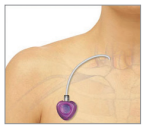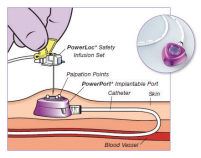Portacath insertion and removal
A portacath (port) is a small device implanted under your skin in the upper chest, providing easy access to one of your larger veins.
Ports can be used for taking blood samples, nutritional feeding, long term IV medications, or chemotherapy. At Intra, ports are inserted for those patients who will be undergoing regular, and long term chemotherapy.
 Some people have either very small veins which can be damaged with the toxicity of the chemotherapy drugs, or have difficult access, making a port ideal for them.
Some people have either very small veins which can be damaged with the toxicity of the chemotherapy drugs, or have difficult access, making a port ideal for them.
The advantage of a port, is that it is under the skin. This helps prevent infection in the line and ensures the portacath can be used for many years if required.
A portacath consists of two parts; the port and a catheter. The port we insert is designed specifically for use during special imaging studies such as CT or MRI scans.
Portacaths are made from materials that are safe for long term use in your body. Overall, a portacath should make receiving your treatment more comfortable for you.
